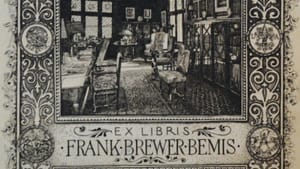Stay in the Loop
BSR publishes on a weekly schedule, with an email newsletter every Wednesday and Thursday morning. There’s no paywall, and subscribing is always free.
Tiny art, big stories
The Rosenbach Museum's The Art of Ownership: Bookplates and Book Collectors from 1480 to the Present

A recent visit to The Art of Ownership at the Rosenbach Museum and Library, a special exhibition devoted to bookplates, filled me with joy. This is a gem of a show, a single, handsomely installed gallery filled with almost 100 tiny, beautiful pieces of art. On its face, it’s a survey of a fascinating, often deluxe category of printmaking.
But the exhibition below the surface is just as arresting. Tagging a book is self-expression, after all. You aren’t just labeling a handful of paper, you’re claiming a place in history for yourself by piggybacking onto something bigger. “I read Don Quixote,” your name says (or, “I meant to read Don Quixote,” anyhow). When you up your game to a bookplate, you say even more. What starts out as a show about bookplates turns into a show about people.
Stories within a story
I get dewy-eyed about books. They’re the landscape of my childhood. My parents couldn’t pass a flea market or church sale without a look in the “All Books 10 Cents!” bin. Every house we ever lived in was packed floor-to-ceiling with shelving and old books.
Open one of these thrift-store treasures and you can find a whole history on its flyleaf. “Ida, from Harry, December 25, 1881,” says my copy of Sarah Orne Jewett’s Deephaven. I have no idea who Harry was, or Ida. On my bookshelf, though, they’re famous.
And then there are the truly famous artists proudly displaying trademark images on their bookplates. Walt Disney’s give us Mickey Mouse. Charlie Chaplin’s have the Little Tramp in silhouette, gazing beyond the horizon. Broadway songwriter Jerome Kern’s have a wonderfully Art Deco-ized violin.
Not surprisingly, powerful people come across as powerful. J.P. Morgan’s bookplate, along with those of Frick, Chrysler, and other Gilded Age robber barons, evoke power. Their bookplates—exquisite examples of the art—show us the elegant libraries that housed their book collections, as well as the ships, trains, and factories that paid for them.
You get an amusing example of cross-branding with Franklin D. and Eleanor Roosevelt’s bookplates. FDR’s is tiny and plain: nothing to prove here. Eleanor’s is the opposite: large and elaborate, designed by Dorothy Sturgis Harding, one of the few women to break the gender barrier in bookplate art.
From Gutenberg to Jobs
My favorites in the show are the outliers, the people who used their bookplates to present against type. A doctor, Stoughton R. Vogel, pushed back on his profession’s positivism with a massive question mark captioned “What do we know?” William Keeney Bixby made a fortune building railway cars, but they don’t figure on his bookplate. Instead, he pictured himself as an octopus grabbing up books in a whirlwind frenzy of acquisition. He wanted to be to be remembered as a collector first, an industrialist never. And so we do.
I wonder about bookplates the same way I wonder about books. I do a lot of my reading digitally now. Last summer, I even read parts of Don Quixote (yes, I really did), the first modern novel, published in 1615, on my iPhone 6, iOS 9, purchased in 2016. Seventeenth-century man, meet 21st-century woman.
Claiming a book for your own appears to be a deeply held instinct. The Rosenbach show includes what is considered the Western world’s oldest bookplate, dating from the 1480s (the Rosenbach owns it). When you consider that the first mass-produced book, the Gutenberg Bible, dates from only the 1450s, you realize we could barely wait for books to be invented before we started pasting our names in them.
I welcome the incursion of digital books into the paper world. They’re useful, even fun. But we’re definitely going to have to figure out where to put our names.
What, When, Where
The Art of Ownership: Bookplates and Book Collectors from 1480 to the Present. Through March 19, 2017, at the Rosenbach Museum and Library, 2008-2010 Delancey Place, Philadelphia. (215) 732-1600 or rosenbach.org.
Sign up for our newsletter
All of the week's new articles, all in one place. Sign up for the free weekly BSR newsletters, and don't miss a conversation.
 Anne Schuster Hunter
Anne Schuster Hunter